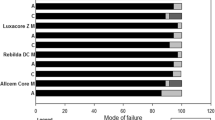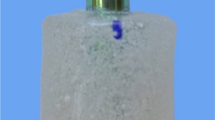Abstract
Objectives
This in vitro study aimed to predict the potential of fracture initiation after long-term incubation (LTI) of lithium-disilicate restorations due to a hygroscopic expansion of self-adhesive resin cement (SARC) used as core build-up material.
Methods
Human maxillary central incisors were divided into four groups (n = 10). Teeth were endodontically treated and decoronated. Specimens were restored in a one-stage post-and-core procedure using experimental dual-curing SARC. Three application protocols to build up the core were compared as follows: I, auto-polymerisation; II, dual curing including 40 s light-initiated polymerisation; and III, an open matrix technique in a dual-curing mode. In group IV, a chemical-curing composite core build-up material served as control. For all specimens, a 2-mm ferrule design was ensured. Full anatomic lithium-disilicate crowns were adhesively luted. One-year LTI in 0.5 % chloramine solution at 37 °C was performed. Restorations were examined after 3, 6, 9 and 12 month of storage. Survival rates were calculated using log-rank statistics (p = 0.05).
Results
Fifty per cent of lithium-disilicate crowns of groups I and II showed visible crack propagation after 9 months of incubation, while one crown failed in group III. No failure was observed in group IV. The survival rates differed significantly (p = 0.017).
Conclusion
SARC used to build up the core of severely damaged endodontically treated teeth does have the potential to cause fracture of lithium-disilicate crown restorations.
Clinical relevance
Hygroscopic expansion of self-adhesive resin cements used as a core build-up material might have an adverse impact on longevity of glass-ceramic crowns.




Similar content being viewed by others
References
Sterzenbach G, Franke A, Naumann M (2012) Rigid versus flexible dentine-like endodontic posts—clinical testing of a biomechanical concept: seven-year results of a randomized controlled clinical pilot trial on endodontically treated abutment teeth with severe hard tissue loss. J Endod 38:1557–1563. doi:10.1016/j.joen.2012.08.015
Ferrari M, Vichi A, Fadda GM, Cagidiaco MC, Tay FR, Breschi L, Polimeni A, Goracci C (2012) A randomized controlled trial of endodontically treated and restored premolars. J Dent Res 91:72S–78S. doi:10.1177/0022034512447949
Naumann M, Sterzenbach G, Rosentritt M, Beuer F, Meyer-Luckel H, Frankenberger R (2011) Self-adhesive cements as core build-ups for one-stage post-endodontic restorations? Int Endod J 44:195–202. doi:10.1111/j.1365-2591.2010.01797.x
Tay FR, Pashley DH (2007) Monoblocks in root canals: a hypothetical or a tangible goal. J Endod 33:391–398
Sterzenbach G, Karajouli G, Naumann M, Peroz I, Bitter K (2012) Fiber post placement with core build-up materials or resin cements-an evaluation of different adhesive approaches. Acta Odontol Scand 70:368–376. doi:10.3109/00016357.2011.603702
Radovic I, Mazzitelli C, Chieffi N, Ferrari M (2008) Evaluation of the adhesion of fiber posts cemented using different adhesive approaches. Eur J Oral Sci 116:557–563
Bitter K, Paris S, Pfuertner C, Neumann K, Kielbassa AM (2009) Morphological and bond strength evaluation of different resin cements to root dentin. Eur J Oral Sci 117:326–333
Bitter K, Perdigao J, Exner M, Neumann K, Kielbassa A, Sterzenbach G (2012) Reliability of fiber post bonding to root canal dentin after simulated clinical function in vitro. Oper Dent 37:397–405. doi:10.2341/11-066-L
De Munck J, Vargas M, Van Landuyt K, Hikita K, Lambrechts P, Van Meerbeek B (2004) Bonding of an auto-adhesive luting material to enamel and dentin. Dent Mater 20:963–971
Hikita K, Van Meerbeek B, De Munck J, Ikeda T, Van Landuyt K, Maida T, Lambrechts P, Peumans M (2007) Bonding effectiveness of adhesive luting agents to enamel and dentin. Dent Mater 23:71–80
Ilie N, Simon A (2012) Effect of curing mode on the micro-mechanical properties of dual-cured self-adhesive resin cements. Clin Oral Investig 16:505–512. doi:10.1007/s00784-011-0527-x
Ito S, Hashimoto M, Wadgaonkar B, Svizero N, Carvalho RM, Yiu C, Rueggeberg FA, Foulger S, Saito T, Nishitani Y, Yoshiyama M, Tay FR, Pashley DH (2005) Effects of resin hydrophilicity on water sorption and changes in modulus of elasticity. Biomaterials 26:6449–6459. doi:10.1016/j.biomaterials.2005.04.052
Versluis A, Tantbirojn D, Lee MS, Tu LS, DeLong R (2011) Can hygroscopic expansion compensate polymerization shrinkage? Part I. Deformation of restored teeth. Dent Mater 27:126–133. doi:10.1016/j.dental.2010.09.007
Leevailoj C, Platt JA, Cochran MA, Moore BK (1998) In vitro study of fracture incidence and compressive fracture load of all-ceramic crowns cemented with resin-modified glass ionomer and other luting agents. J Prosthet Dent 80:699–707
Sindel J, Frankenberger R, Kramer N, Petschelt A (1999) Crack formation of all-ceramic crowns dependent on different core build-up and luting materials. J Dent 27:175–181
Braden M, Causton EE, Clarke RL (1976) Diffusion of water in composite filling materials. J Dent Res 55:730–732
Blunck U, Zaslansky P (2007) Effectiveness of all-in-one adhesive systems tested by thermocycling following short and long-term water storage. J Adhes Dent 9(Suppl 2):231–240
Feilzer AJ, De Gee AJ, Davidson CL (1987) Setting stress in composite resin in relation to configuration of the restoration. J Dent Res 66:1636–1639
Martin N, Jedynakiewicz NM, Fisher AC (2003) Hygroscopic expansion and solubility of composite restoratives. Dent Mater 19:77–86
Sideridou I, Tserki V, Papanastasiou G (2003) Study of water sorption, solubility and modulus of elasticity of light-cured dimethacrylate-based dental resins. Biomaterials 24:655–665
Radovic I, Monticelli F, Goracci C, Vulicevic ZR, Ferrari M (2008) Self-adhesive resin cements: a literature review. J Adhes Dent 10:251–258
Ferracane JL, Stansbury JW, Burke FJ (2011) Self-adhesive resin cements—chemistry, properties and clinical considerations. J Oral Rehabil 38:295–314. doi:10.1111/j.1365-2842.2010.02148.x
Ruttermann S, Alberts I, Raab WH, Janda RR (2011) Physical properties of self-, dual-, and light-cured direct core materials. Clin Oral Investig 15:597–603. doi:10.1007/s00784-010-0405-y
Ruttermann S, Kruger S, Raab WH, Janda R (2007) Polymerization shrinkage and hygroscopic expansion of contemporary posterior resin-based filling materials—a comparative study. J Dent 35:806–813. doi:10.1016/j.jdent.2007.07.014
Naumann M, Sterzenbach G, Rosentritt M, Beuer F, Frankenberger R (2010) In vitro performance of self-adhesive resin cements for post-and-core build-ups: influence of chewing simulation or 1-year storage in 0.5 % chloramine solution. Acta Biomater 6:4389–4395. doi:10.1016/j.actbio.2010.05.023
Sterzenbach G, Rosentritt M, Frankenberger R, Paris S, Naumann M (2012) Loading standardization of postendodontic restorations in vitro: impact of restorative stage, static loading, and dynamic loading. Oper Dent 37:71–79. doi:10.2341/10-355-L
Naumann M, Preuss A, Frankenberger R (2007) Reinforcement effect of adhesively luted fiber reinforced composite versus titanium posts. Dent Mater 23:138–144. doi:10.1016/j.dental.2006.01.002
Naumann M, Sterzenbach G, Rosentritt M, Beuer F, Frankenberger R (2008) Is adhesive cementation of endodontic posts necessary? J Endod 34:1006–1010. doi:10.1016/j.joen.2008.05.010
Saskalauskaite E, Tam LE, McComb D (2008) Flexural strength, elastic modulus, and pH profile of self-etch resin luting cements. J Prosthodont 17:262–268
Spinell T, Schedle A, Watts DC (2009) Polymerization shrinkage kinetics of dimethacrylate resin-cements. Dent Mater 25:1058–1066. doi:10.1016/j.dental.2009.04.008
Soh MS, Yap AU, Yu T, Shen ZX (2004) Analysis of the degree of conversion of LED and halogen lights using micro-Raman spectroscopy. Oper Dent 29:571–577
Goracci C, Cury AH, Cantoro A, Papacchini F, Tay FR, Ferrari M (2006) Microtensile bond strength and interfacial properties of self-etching and self-adhesive resin cements used to lute composite onlays under different seating forces. J Adhes Dent 8:327–335
Acknowledgments
This study was financially supported by 3M ESPE.
Conflict of interest
The authors declare no conflict of interest.
Author information
Authors and Affiliations
Corresponding author
Rights and permissions
About this article
Cite this article
Sterzenbach, G., Karajouli, G., Tunjan, R. et al. Damage of lithium-disilicate all-ceramic restorations by an experimental self-adhesive resin cement used as core build-ups. Clin Oral Invest 19, 281–288 (2015). https://doi.org/10.1007/s00784-014-1263-9
Received:
Accepted:
Published:
Issue Date:
DOI: https://doi.org/10.1007/s00784-014-1263-9




